More Bass Are Caught Carolina Rig Fishing Than With Any Other Technique

What's great about the Carolina Rig fishing is the rigs ease of use and ability to catch bass by even the inexperienced angler. It can be cast and retrieved effectively after only a short learning curve. It's the ideal deep water structure technique but has evolved into a shallow water method as well.
The components that make up a Carolina Rig are simple. As shown below you need only a sinker, plastic bead, clacker, swivel, hook and of course a plastic lure.
Carolina Rig Components
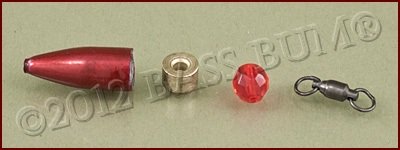
Carolina Rig with Green Pumpkin ZMan CreatureZ
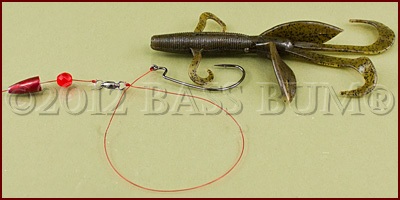
It's reasonable to consider it as the "gold standard" for fishing soft plastics and getting bites year round. While there are many techniques and rigs available to today's angler none of us should ever forget the venerable Carolina Rig. In the Carolina Rig section of this site you can see the many different ways to fine tune this rig. Fish them in the right places and you will catch bass.
Tackle For This Technique Varies
RODS and REELS
Many anglers insist on nothing but baitcasting reels for Carolina Rig fishing. They argue these should be high speed so line can be taken up quickly preventing the bass from getting into less than hospitable cover after the hook set. Furthermore, they feel it quickly takes up slack line helping with long distance hook sets, which are the rule in Carolina Rig fishing. Others, probably the minority, feel a low speed reel is better. The rod is usually a 7 to 7 1/2´ medium-heavy baitcaster.
Others, like myself, prefer spinning reels to baitcasters. Since a bass taking a lure at the end of a Carolina Rig doesn't usually produce the classic "tick" or "tap" you feel with other rigs, feel is even more important to detecting a strike on a Carolina Rig. The lure is on a leader as much as two feet from the main line and sinker so you must be tuned in to the feel of a "pick up" or simply increased resistance. Again, the rod is best if a 7 to 7 1/2´ in length, medium-heavy action and a spinning rod of course.
A spinning reel and rod provide me the greater sensitivity I think is needed. My preferred setup when Carolina Rig fishing deep structure is a G.Loomis SJR 844 7´ heavy-fast spinning rod with a Daiwa 4500S spinning reel rated for 10-17lb line and lures up to 1oz.
LINE
Monofilament line that is abrasion resistant from 17-25lbs is most often used for the main line. Leaders are 10-12lb fluorocarbon ranging from 2 -3´ in length. Some anglers prefer "super lines" because they feel they telegraph strikes better and since these lines are low stretch, they minimize problems when setting the hook at long range.
Leader length is important. A long leader, 3-6´, helps give the lure movement that has a more natural look. This is a serious consideration when fishing clear water. In shallower water, say 5-10´ deep, a shorter leader 1-2´ is appropriate. Shorten your leader and include "clackers" when fishing heavily stained water. Short leaders of 1 1/2´ to 3´ are good for fall and winter. Why? Bass, especially largemouth, are usually holding closer to structure and cover that time of year. Some anglers will use very long leaders, 5-7´ long, in summer around ledges and deeper water giving bass a chance to see the lure undulating by. You may have a difficult time casting 5-7´ setups, I know I do.
LURES
When Carolina Rig fishing you can put just about any lure on the rig and it will likely work. The historic favorite is the plastic lizard, especially in spring when bass are very active. After the spawn smaller baits such as French fries, small tubes, short Senkos, craws and 4-6" worms are probably better.
Floating Lizard Carolina Rig
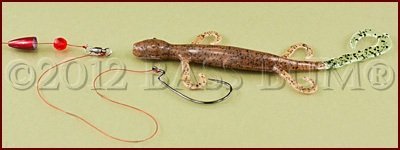
Lures that "float"
should be considered for Carolina Rig fishing, particularly if you're
working grass. A decently long leader allows floating lures to move
above the top of the grass.
Tube and Flotation Devices
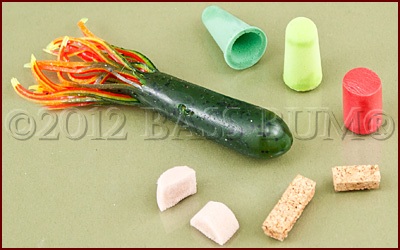
I've used floating lures like the ZMan LizardZ above and I've inserted Styrofoam inside tubes etc. A great source for Styrofoam is ear plugs. They can be readily found in many grocery and drug stores. Just cut to size. Cork works great too.
Pay attention to hook size when using floating lures. A 3/0 or 4-0 hook, even a light wire model, will sink most any lure, floating or not! A 1/0 or 2/0 is appropriate for even a 6" lizard unless it's buoyant then a larger hook will work.
Non-floating lures sink to the bottom regardless of leader length. When the rig is "dragged" along the bottom with a sideways sweep of the rod, the lure may raise up from the bottom momentarily then sink back to the bottom. This action can also attract bass.

WHERE TO FISH A CAROLINA RIG
Carolina Rig fishing is ideal for fishing deep structure and great for working shallow grass edges.
A Carolina Rig can get a bait down 20 plus feet, beyond the depth most crankbaits can reach. It places your lure in their face enticing both active and inactive bass, depending on the speed at which you work the lure. Identify deep water structure with your GPS/depth finder like humps, stumps, submerged weed beds and house foundations and then then work them over with a Carolina Rig.
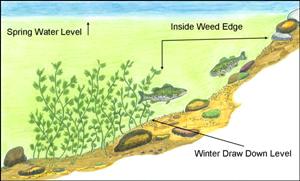
It also excels in fishing "inside" weed lines and transition points between weeds and hard bottoms. If you know the water level of winter draw down in the reservoir you're fishing you will know where the inside edges are once the water is returned to normal pool. Fish a Carolina Rig between this inside edge and the shore. Position your boat outside of the inside weed line and cast perpendicular to it.
Long, sloping points are also great candidates for Carolina Rig fishing. Find one which runs from shallow to deep water and has a drop off on one side or both if possible. If there is some form of cover on the point that's a bonus for holding fish.

WHEN TO FISH A CAROLINA RIG
Though there is no bad time for Carolina Rig fishing there are seasonal differences that you might want to consider.
Spring calls for using the Carolina rig to probe migration routes such as roads, creek channels and ditches. This is also the time to use it fishing inside edges of weed beds. Spawning bass can also be caught by working this rig in and among their beds.
Summer is when you will use this rig for fishing deep offshore structure as well as inside weed edges.
Fall is a good time for using the rig with smaller lures and also with a suspending or floating hard bait, especially in highland reservoirs that are rocky with deep sloping points.
Winter calls for extremely slow movement of the Carolina rig. Bass may be sluggish but they must still eat.

HOW TO FISH A CAROLINA RIG
There are two primary retrieves when Carolina Rig fishing. First, the rig is "dragged" across the bottom. By drag, I mean it is pulled a few feet with your rod and slack is reeled up before again dragging the rig forward. A bite often feels merely like additional weight. Should you detect this reel up and set the hook with a sideways sweeping motion.
When making your retrieve remember that long sweeps of the rod force a "floating" lure downward to the bottom where it will again begin its upward rise. Lures that are not buoyant stay on the bottom even while being dragged. Dragging is best when fishing relatively uncluttered bottoms.
Secondly, the rig can be retrieved by lifting and dropping the weight which will cause the lure to follow and then slowly drift back to the bottom. Remember, many strikes occur as a lure drops. This is a good technique if you're fishing reservoirs whose bottoms are heavily covered with rocks as you will hang up less by lifting the rod vertically rather than dragging it.
Return to Bass Fishing Techniques From Carolina Rig Fishing
